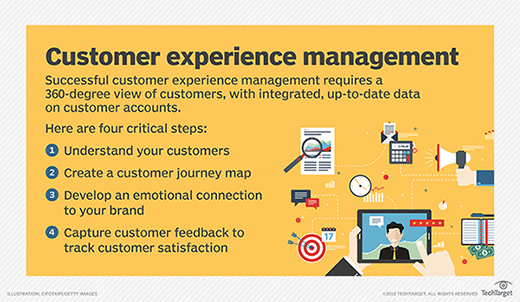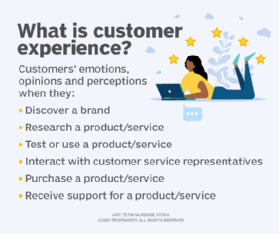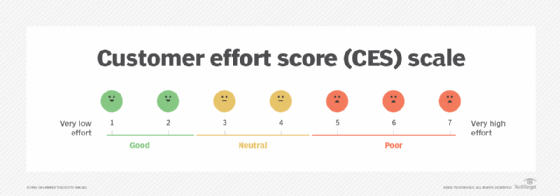What is a customer effort score (CES)?
Customer effort score (CES) is a system for evaluating how much effort is required on the part of a customer to achieve satisfaction in their experience with a company. As a metric used by businesses, it gauges the ease with which customers can get their issues resolved, requests fulfilled or questions answered.
Usually calculated by averaging the response to a single follow-up survey question after a customer support experience, the customer will be asked to rate the interaction on a scale of "very difficult" to "very easy." Alternatively, CES surveys can use a Likert scale or an emoticon-based system to gather customer feedback. This score comes from the idea that customers are more willing to punish an organization for poor user experience than reward them, therefore weaknesses need to be identified and addressed.
The higher the CES, the easier the experience is from start to finish for a customer trying to meet a specific need. Actions that can be measured with customer effort scores include making a purchase, resolving an issue, registering for a service or visiting a website. CES can also be used across various touchpoints in the customer journey, such as browsing, signing up for services and completing transactions. Evidence has shown that the amount of effort needed is often correlated with how likely the consumer will continue to use, subscribe or pay for a company's product or services.
Customer effort scores can be improved by streamlining support channels, minimizing the repetition of information and decreasing the amount of wait time or transfers necessary during a phone call. In addition, reducing friction in digital experiences such as website navigation or chatbots helps improve CES and increase customer retention. Measuring the CES can lead to higher overall customer satisfaction scores (CSATs), better customer loyalty, more efficient support documentation and lower customer service costs.

History of the customer effort score
The inception of the CES can be traced back to the late 2000s, when organizations started realizing that while overall satisfaction and loyalty were essential metrics, there was a missing piece in understanding the intricacies of customer interactions.
The term was popularized in 2010 by the Harvard Business Review in its study titled "Stop Trying to Delight Your Customers," which emphasized the importance of reducing customer effort to build loyalty.
This gap was especially apparent in post-service or post-purchase situations. Businesses wanted a more specific measure that could help them identify and rectify pain points in real time. In other words, making it easier for customers to get their issues resolved can be a more reliable way to increase loyalty.
Customer effort score vs. Net Promoter Score vs. customer satisfaction score
In contrast to the Net Promoter Score (NPS) -- which gauges a customer's willingness to recommend a company -- CES zeroes in on the ease of interactions. While NPS provides a broader view of customer loyalty, CES offers insight into the direct experiences of customers.
NPS may indicate long-term loyalty, but CES helps pinpoint where friction occurs during specific interactions, making it actionable for businesses.
Similarly, the CSAT is aimed at understanding a customer's satisfaction level with a product or service. However, CSAT often revolves around broader sentiments, like happiness or satisfaction, which can be influenced by numerous external factors.
CES, on the other hand, offers a more granulated approach, focusing exclusively on the effort exerted by customers during their interactions.
Why customer effort score matters
Understanding the intricacies of customer interactions goes beyond mere metrics and data points; it delves into the core of brand loyalty and business success. By focusing on reducing effort, businesses can improve customer retention, lower churn rates and gain a competitive edge.
At first glance, it might seem intuitive to think that wowing customers or exceeding their expectations would be the key to winning their loyalty. However, more often than not, customers aren't looking for over-the-top experiences -- they simply want their interactions to be hassle-free. In essence, the less effort a customer must expend, the more likely they are to return and engage with a brand.

Every time a customer encounters an obstacle, whether it's navigating a complex website, going through a lengthy return process or being transferred multiple times during a call, their likelihood of turning to a competitor increases.
Conversely, seamless experiences foster trust and confidence in a brand. When customers know they can get their issues resolved quickly and easily, they are more inclined to stay loyal and continue their relationship with the business.
In a world where customers are bombarded with choices and the competition is just a click away, businesses can't afford to overlook the importance of CES. It's not just another metric -- it's a reflection of how well a business understands its customers' needs and how effectively it can deliver on its promise of effortless interactions.
How customer effort score is measured
The beauty of the CES lies not just in its relevance but also in its simplicity. By focusing on one core element of the customer experience -- the effort -- it provides businesses with direct feedback that can be quickly acted upon. Some CES surveys may include an open-ended follow-up question to gather more detailed insights.
The CES survey is typically concise to ensure a high response rate. A common format involves a single question focused on the effort required from the customer's side. It's essential that the question remains consistent across surveys to ensure accurate tracking over time.
CES is typically measured on a scale from "very low effort" to "very high effort." Most commonly, CES is measured on a scale from 1 to 7, where 1 represents "very low effort" and 7 indicates "very high effort."
The goal for businesses is to achieve as low a score as possible, indicating that customers can interact with them effortlessly.
The digital age has brought forth a variety of tools and platforms that help businesses measure CES seamlessly. Some prominent tools include Medallia, Qualtrics, SurveyMonkey and Zendesk. Using these tools, companies can not only capture CES data but also integrate it with other metrics and data sets, providing a comprehensive view of the customer experience.

Interpreting CES results
Gathering CES data is just the initial step. The true value emerges when businesses can interpret these results effectively to drive actionable insights. But how can one differentiate between a good and a poor score? And how do organizations position their score in the larger industry context? Let's delve deeper.
Given that the typical CES scale ranges from 1 (very low effort) to 7 (very high effort), lower scores are generally more desirable, indicating that customers found it easy to interact with the company.
- Good CES. Scores of 1 or 2 usually suggest that customers found their experience effortless. These are the scores businesses should aim for, as they're indicative of streamlined processes and effective customer service.
- Neutral CES. Scores around the midpoint, like 3 or 4, suggest that there's room for improvement. While not drastically high, these scores indicate that customers did encounter some friction.
- Poor CES. Scores of 5 to 7 highlight significant challenges. Customers who provide these scores likely faced obstacles or complications during their interactions. Businesses should analyze these high-effort interactions closely to identify areas where processes can be optimized.
It's also essential for companies to contextualize these scores against industry benchmarks to get a clearer picture of where they stand.
Many customer experience research firms and agencies release annual or biannual reports that highlight industry-specific CES benchmarks. Acquiring and comparing against these can provide businesses with a relative positioning.
Benchmarking isn't only external. Businesses can also compare current CES against past scores to track progress or regression over time.
The significance of analyzing the distribution of scores
While the average CES provides a quick snapshot, analyzing the distribution of scores is crucial for a nuanced understanding:
- Skewed distributions. If scores lean heavily toward the high or low end, it indicates a more unanimous sentiment among customers. For instance, a significant number of scores at 1 or 2 shows strong positive sentiment, while a clustering at 6 or 7 indicates widespread issues.
- Polarized scores. If there's a noticeable split, with many scores at both the low and high ends but few in the middle, it suggests inconsistent customer experiences. Some customers are highly satisfied, while others are very frustrated.
- Centralized scores. A majority of scores hovering around the middle suggests that the experiences are neither particularly bad nor especially good. This often points to a lack of differentiation in the service or product offering.
Interpreting CES results requires a multifaceted approach. Beyond the raw score, businesses must consider the broader industry context and delve deep into the distribution to extract meaningful, actionable insights.
Advantages of customer effort score
The CES has rapidly grown in popularity among businesses of all sizes and industries. Its rise to prominence isn't merely a trend; it's anchored in the tangible benefits that CES offers to organizations. Following are some of the primary advantages of using this metric.
1. Quick feedback loop: Immediate insight post-interaction
One of the most significant strengths of CES is its ability to provide businesses with instant feedback. Unlike some other metrics, which might require extended survey formats or are gauged periodically, CES is typically measured right after a customer interaction, be it a purchase, service request or any other touchpoint.
2. Pinpointing specific pain points in customer interactions
CES narrows down the focus to one critical aspect: the effort exerted by the customer. By doing so, it serves as a targeted tool to identify friction points in the customer journey. High CES scores in specific interactions can signal bottlenecks or areas of inefficiency that need attention.
Instead of broad sentiments like happiness or dissatisfaction, the effort-centric feedback can be directly tied to tangible aspects of the service or product, enabling businesses to make precise improvements.
3. Guiding process improvements and resource allocation
The insights derived from CES don't just stop at identifying problems; they actively guide businesses in enhancing their processes. By understanding where customers face the most significant hurdles, companies can prioritize areas of improvement and allocate resources more effectively.
In essence, CES is not just a metric; it's a compass that directs businesses toward customer-centric growth. By focusing on effort, companies can hone in on the nuances of customer interactions, making the entire journey smoother, more pleasant and more aligned with customer needs and expectations.
Limitations and criticisms of customer effort score
Unfortunately, surveying CES is not without its limitations. Like all tools and methodologies, CES comes with certain limitations that businesses should be aware of when integrating it into their feedback arsenal. Here are some of the primary critiques and challenges associated with CES.
1. The narrow focus: Measures only effort, not overall satisfaction or likelihood to promote
One of the most common criticisms of CES is its specificity. While it excels in measuring effort, it doesn't capture a holistic picture of customer sentiment. For example, a customer might find an interaction effortless but still be unsatisfied with the product or service. Similarly, an interaction might require effort but lead to a highly valuable outcome, leaving the customer satisfied.
2. Potential ambiguities in phrasing or interpretation
How questions are phrased and presented can lead to variations in how customers interpret and respond. What does "effort" mean to different individuals? For some, it might refer to time spent, while for others, it could relate to the emotional strain or complexity of a task.
If not clearly defined, the scale (from "very low effort" to "very high effort") can be interpreted differently by respondents, leading to inconsistencies in data.
3. External factors can sometimes affect the perceived effort
Many factors can influence a customer's perception of effort, and not all are directly related to a company's processes or service. For example, a customer might be having a bad day or could be distracted, affecting their perception of effort during an interaction.
Additionally, issues like slow internet speeds or device malfunctions, outside of a company's control, can amplify perceived effort, skewing the CES.
While CES is a potent tool for gauging specific aspects of the customer experience, it's essential to understand its boundaries. By complementing CES with other metrics and being mindful of its limitations, businesses can ensure they obtain a well-rounded understanding of their customer landscape.
Learn more about the voice of the customer, which is the component of customer experience that focuses on customer needs. Explore why businesses need voice of the customer analytics and how to collect customer feedback. See the business benefits of a customer self-service strategy and how to turn customer feedback into actionable insights. Explore seven must-have skills for customer experience professionals and five tips for creating customer journey maps from buyer personas.






